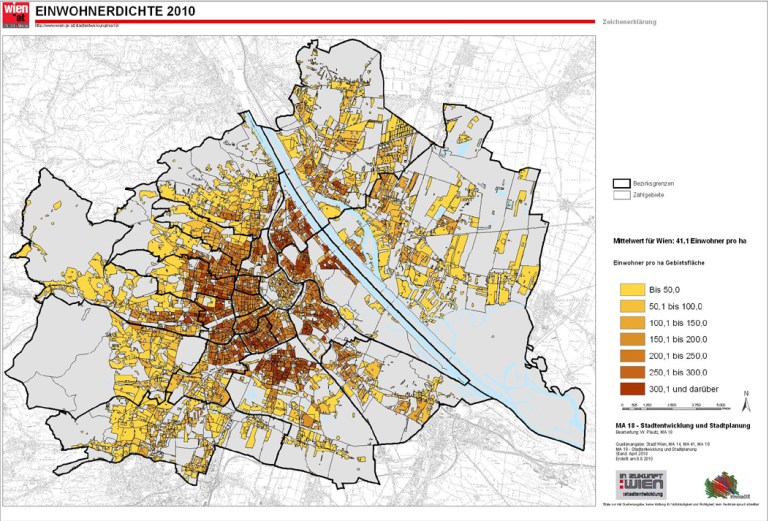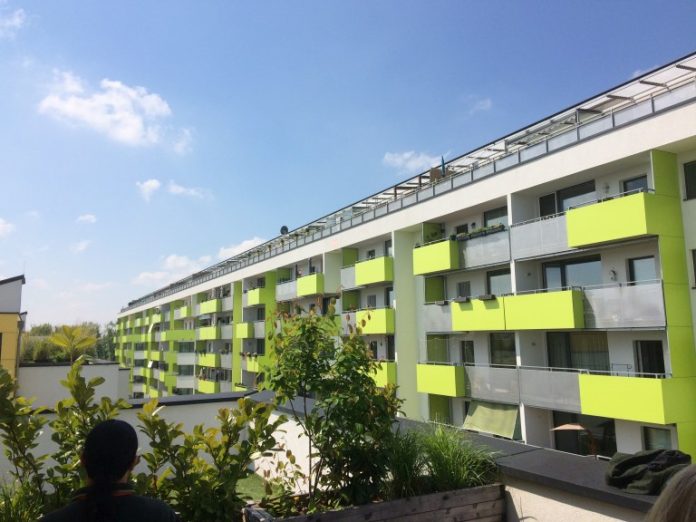Allowing multi-family housing in all residential zones, and aggressively promoting private bidding lowers housing costs.
Part II: Zoning and Development in Vienna
Previously, I discussed demographic and funding allocations of social housing in Vienna, compared to Seattle. (See Part I of this series.) This segment will look at the zoning and development policies, compared to Seattle.
Urban planning in Vienna is incredibly comprehensive, and the city undergoes a rigorous citizen engagement and planning exercise when developing or redeveloping areas. The Bauträgerwettbewerbe are a critical component of achieving high quality, dense, and livable housing cost effectively. Teams compete to develop and receive subsidies for individual projects, and are judged by a diverse panel on the economics of the project, the architecture, ecology of the building, and the social mix. The city has effectively leveraged its purse to push the price of construction down, making developers compete on the merits and economics. This results in buildings that are incredibly innovative across the board–you can see past winners from Stadt Wien, and there’s even a 24-story cross laminated timber tower underway in Seestadt Aspern.
Seattle’s planning process is less comprehensive. Much is left to the market to decide where things should go. Large developments are the exception, rather than the norm. And while Seattle has attempted to stimulate innovation , those efforts have largely fallen flat. Not only does Seattle thwart innovation, but we also allow homeowners to slow and kill housing units through excessive design review and other forms of predatory delay.
The amount of land zoned exclusively for single-family houses in Vienna is zero. Just 9% of the dwelling units in Vienna are single-family homes. In Seattle, 44% of dwelling units are single-family homes and almost 75% of non-industrial parcels are reserved for this least dense, least sustainable form of housing. We’re constantly digging out of a hole, and until we start thinking more holistically and at a drastically larger scale, we’ll never get out.

Vienna has neighborhoods, but density isn’t limited to just a few urban villages. The density of Vienna is largely centralized and relentless. Seattle’s urban villages held promise, but many are severely gerrymandered and the zoning within them is largely deferential to single-family zoning inside and outside the demarcated areas. Vienna’s zoning is broad and deep–generally six to eight stories over several blocks–whereas Seattle’s density usually starts well under eight stories and steps down to single-family zoning quickly, making for weak, car-dominated urbanism and high housing prices. Vienna has walksheds that are nearly three-quarters of a mile in new development. We hope that Seattle gets to a half-mile walkshed one day.
Additionally, Vienna, isn’t afraid to convert former industrial lands to housing, a topic that is taboo in Seattle. Vienna recently redeveloped one of its airports just minutes from the city to the Seestadt Aspern district which will house 20,000 residents and 20,000 jobs, on less than 600 acres–plus parks, schools, and stores. Likewise, the former railyards in Nordbahnhof district are also being redeveloped into dense urban housing for 25,000–with parks, schools, institutions, jobs. Seattle could be doing this, but tragically, we have more land zoned for industry than we do for multifamily housing. We do redevelop a fair amount of industrial land–but mainly for just different types of jobs (e.g., offices instead of manufacturing). And while we’ll likely never turn Boeing Field into a larger version of Seestadt Aspern–we should be looking more critically at how and where we can easily accommodate more housing.
Crosscut’s Joe Copeland wrote in his piece describing Vienna housing policies that much of the new social housing in Vienna is low rise–and while projects on the outer districts do trend toward lower buildings, much of the social and market housing built today would not be considered low rise by Seattle residents. Most projects are greater than four stories, and though they are dense, they provide amenities unheard of in Seattle–especially for non-luxury housing. To get a glimpse of recent housing projects in Vienna, a Viennese catalogue captures a broad spectrum of examples.
Vienna’s history of extensive density allows for another innovative form of gentle urban renewal–rooftop additions (aufstockungen). Rooftop additions are everywhere in Vienna, and in some places the city is allowing market rate to be built to offset rents for the remainder of the building. In others, the city itself is adding roof top units as it rehabs existing buildings. While several hundred are underway each year, it is estimated that 25,000 rooftop housing units could be added over existing buildings. We would be hard pressed to easily accommodate 25,000 new units over existing single-family homes in Seattle.
Tenure in Austria is wholly different from the US. For one, housing contracts in Austria are primarily indefinite, versus one-year contracts. This reduces the stress of constantly having to find new housing or accept rent increases. As an added security, because Vienna’s social housing is intended to result in economically diverse communities, there is only a limit upon starting tenancy, and increased wages do not result in households being pushed into market rate rentals. Additionally, depending on the type of unit, some can be passed on to family members. This ensures that there are no neighborhoods that are overwhelmingly wealthy or poor, but rather a diverse mix. To this point, some of the most expensive single-family houses in Vienna sit opposite the street of gemeindebauten. Seattle’s rampant exclusionary zoning prevents this sort of mixing from happening. Instead of slowing gentrification, our restrictive zoning accelerates it.
Vienna, like Seattle, is also majority renter. This means the city does not have land use policies that are easily co-opted or dominated by homeowners. The city encourages very broad participation in planning. There are no policies preserving single-family homeowners views and street parking,. And unlike Seattle, most parks are surrounded by dense, multifamily neighborhoods. Fifty percent of Vienna is green space, and going forward–the city is aiming to keep that ratio despite adding new housing. Such a goal would be extremely difficult given the plethora of land dedicated in Seattle to sprawl, essentially. Vienna’s planning documents are a thing of beauty.
Vienna could be an ideal model for Seattle. It’s dominated by left-leaning politics. It’s majority renter. It builds more social housing than market rate. But our zoning, our lack of vision and leadership, our lack of comprehensive planning, our lack of innovation, and most importantly, our lack of funding make such a model difficult to obtain. Vienna is doing almost everything right. Perhaps it is time for Seattle too, as well.
This article is a cross-post that originally appeared on City Observatory.
Mike is the founder of Larch Lab, an architecture and urbanism think and do tank focusing on prefabricated, decarbonized, climate-adaptive, low-energy urban buildings; sustainable mobility; livable ecodistricts. He is also a dad, writer, and researcher with a passion for passivhaus buildings, baugruppen, social housing, livable cities, and car-free streets. After living in Freiburg, Mike spent 15 years raising his family - nearly car-free, in Fremont. After a brief sojourn to study mass timber buildings in Bayern, he has returned to jumpstart a baugruppe movement and help build a more sustainable, equitable, and livable Seattle. Ohne autos.


